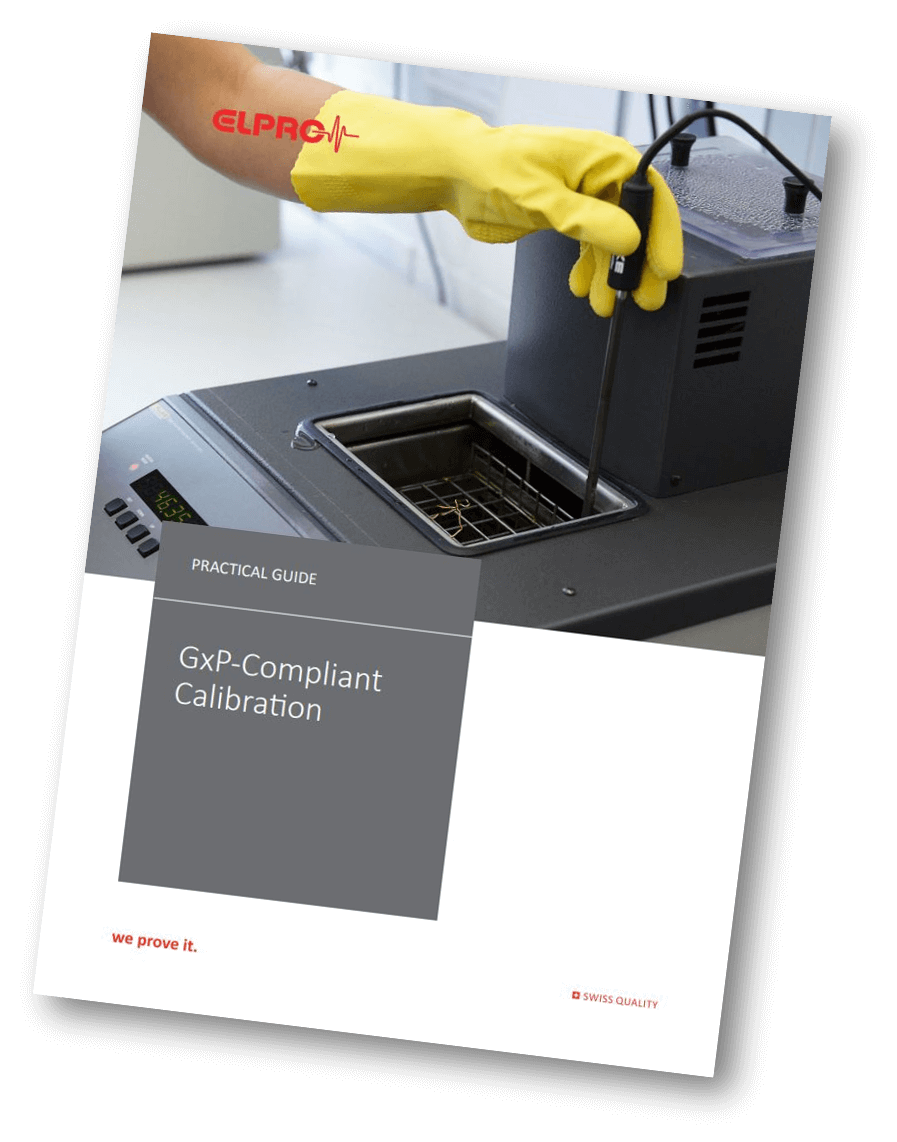Temperature Calibration: All You Need to Know About Temperature Sensor Calibration
Find out more about the process of a temperature calibration and
why it is necessary to conduct a sensor calibration.
What is a Temperature Calibration?
Temperature sensor calibration is a reliable, reproducible, and documented comparison of an instrument under test (data logger, temperature sensor, thermometer, or temperature probe) with a reference standard or reference thermometer traceable to international standards (e.g., ISO 17025, ITS-90).
A temperature calibration compares real temperature values measured by the device under test against a reference sensor that has been calibrated in an accredited calibration laboratory (Switzerland: SAS/SCS, USA: ANAB, Germany: DAkkS, UK: UKAS). These laboratories issue traceable calibration certificates with defined measurement uncertainty.
Calibration is always performed at defined temperature points across a specified temperature range. A stable environment is generated using equipment such as:
- Temperature Calibrator systems including Dry Block Calibrators or a liquid bath
- A reference thermometer traceable to national or international standards
- Fixed reference points such as the freezing point or ice point for high-accuracy benchmarks
Examples:
- Temperature calibration uses a dry block calibrator or liquid bath to stabilize temperatures across a defined range
- Humidity calibration uses reference salts or humidity generators at controlled temperatures
The readings of the measuring instrument and reference instrument are compared. If deviations are detected, the sensor may be adjusted or replaced. Results are documented in a calibration certificate including deviations, uncertainty, and compliance against specification.
Why a Temperature Calibration is Necessary From a Regulatory Perspective
Calibrated thermometers and data loggers are typically used in the GDP environment where packaged pharmaceutical products are stored and transported. Regardless which guidance document in the GDP-environment you consult (FDA, EU, PDA, ISPE, WHO, USP or ICH) – most of them require to work with “calibrated sensors”. Some more extreme interpretations require an ISO 17025 calibration also for cold chain shipments.
Calibration certificates are popular reference documents asked for during FDA audits. An example question could be, “Shipment 123 which took place on October 1st two years ago. Can you show me the data from the temperature data logger used for the product release? And can you also show me the calibration certificate from this specific data logger?” The calibration certificate should be available from anywhere and at any time and therefore stored in a safe cloud database.
/Sensor%20Calibration/In%20process%20Calibration.png?width=859&height=839&name=In%20process%20Calibration.png)
Why a Temperature Calibration is Necessary
From a Technical Perspective
The core of each Data Logger is its measurement sensor. Each sensor type has a specific measurement range and accuracy and different strengths and weaknesses. Before the sensors are installed into a data logger, each sensing element is calibrated, i.e. tested on its accuracy, documented and thus exactly within the defined specification. The change of the accuracy over time is called “drift”. After one year, the sensor will be recalibrated to verify if the sensor accuracy is still within specification.
What is an “in-process calibration”?
An in-process calibration is a faster, less reliable and cheaper way to calibrate. It is mostly used on thermometers and is typically performed on-site and without using a calibration bath or block. It simply compares the current reading of a device under test and the reference device. An in-process calibration is by definition only performed at the current process temperature. In-process calibrations don’t have a very high reputation since the theoretical risks of measurement errors is higher. However, they still deliver a strong indication of the accuracy of the tested device.
What causes "drifts"?
Drift can occur due to physical influences and the ageing of components over time. The risk for drift varies depending on the sensor type, as it depends strongly on the measuring principle used and how well the sensing element is protected.
Temperature sensors have a minimal risk of drift. In all applications - rooms and equipment as well as transportation - they are usually stable over many years.The risk for drift of humidity sensors depends on the application and the sensing technology.
As a general rule the following applies:
1. Use capacitive humidity sensors for room temperature environments and transport.
2. Use electrolytic humidity sensors for high precision applications (e.g., cleanrooms) or for extremely dry or wet environments (e.g., hot cabinets, incubators)
/Sensor%20Calibration/Risk%20of%20Drift.png?width=930&height=624&name=Risk%20of%20Drift.png)
How Often Should Sensors be Calibrated?
How often sensors should be calibrated depends largely on the operating environment, the measurement frequency, and the required accuracy. In pharmaceutical environments, annual calibration intervals are common, while in GMP-critical applications, semi-annual or even shorter intervals are often recommended. A complete calibration history is also crucial: it shows deviations over time, facilitates audits, and provides traceable quality evidence for all measurement points.
Calibration vs. Adjustment—What is the difference?
Calibration and adjustment fulfill different but complementary tasks: While calibration documents the actual deviation of a sensor, adjustment actively corrects this deviation. Both steps are therefore necessary for reliable measurement data in pharmaceutical environments. If sensors are only adjusted without regular calibration, there is no proof of actual measurement accuracy—a risk for quality processes, batch releases, and audits.
The Life-Cycle of a Data Logger
To understand the term calibration, it is vital to know about the physical and technological properties of a data logger and its life-cycle. Calibration as such is not making a sensor more accurate. Accuracy is a quality built by design. The right sensor is chosen already during the engineering of a data logger and carefully built into the device using the right algorithm. Each sensor is calibrated already during production before it is build into the data logger. Afterwards, several checks and sample tests are performed in order to verify that the product meets all requirements – including accuracy. So when a data logger leaves the factory it meets all requirements, which is often stated in a validation certificate, and it has a production calibration certificate.
Would you like to know more about the differences between wired and wireless sensors? Download our infosheet on everything you need to know about using wireless sensors for temperature monitoring.
Why to Re-Calibrate Temperature and
Humidity Sensors After One Year?
From a technical point of view, recalibration of temperature sensors makes little sense, as the risk of drift is minimal and there are indications that these sensors will be stable for many years. So why replace or calibrate temperature sensors after one year? Due to regulatory requirements. Regardless which guidance document in the GxP-environment one consults (FDA, EU, PDA, ISPE, WHO, USP or ICH) – in general they all require “calibrated sensors”. While some guidance documents are more general and just write “calibrated sensors must be used”, others are more specific requesting “regularly calibrated sensors” or even “yearly calibrated sensors”. Some auditors even tend to do an extreme interpretation of the regulations requiring "ISO 17025 calibrated single-use sensors" for transportation. There is no general rule of what regulation requires but most auditors appreciate a risk based approach considering the measurement range of the application as well as the type of sensor used.
Temperature sensors have a minimal risk of drift. In all applications - rooms and equipment as well as transportation - they are usually stable over many years.The risk for drift of humidity sensors depends on the application and the sensing technology.
/Sensor%20Calibration/calibration%20risk%20based%20approach-1.png?width=721&height=483&name=calibration%20risk%20based%20approach-1.png)
How to Calibrate Different Types of Temperature Sensors
During production, temperature sensors are tested and calibrated and the results are documented with the name "as found calibration". Then the sensors are adjusted to match the expected temperature value and are tested once more. The new results are called "as left calibration". Since resistance thermometers (NTC, PT100, and Digital temperature sensors) have a very low drift, they typically don't need to be re-adjusted during re-calibrations. If a temperature sensor is outside tolerance it is very likely that it has been physically damaged. Therefore, it is typically exchanged.
/Sensor%20Calibration/Re-Calibration%20of%20temperature%20sensors-3.png?width=1184&height=543&name=Re-Calibration%20of%20temperature%20sensors-3.png)
Not all temperature sensors are calibrated in the same way. The temperature sensor calibration process varies depending on construction, sensitivity, and application. While resistance-based sensors tend to show minimal drift, other sensor types require different handling, calibration points, and verification techniques.
Below is a practical overview of how the most common temperature sensors are calibrated in pharmaceutical and laboratory environments:
Resistance Temperature Detectors (RTDs)
RTDs (e.g., Pt100 and Pt1000) are widely used for their high-accuracy and long-term stability.
Calibration method:
- Typically performed in a liquid bath or dry block calibrator
- Compared against a reference thermometer traceable to ITS-90
- Multiple calibration points across the working temperature range
- Calibration uncertainty is typically low compared to other sensor types
RTDs rarely require readjustment unless physically damaged.
Thermistors
Thermistors are highly sensitive and typically used for narrow temperature ranges.
Calibration procedure:
- Performed using a fixed-point reference or stable temperature bath
- Drift is higher than RTDs, so recalibration frequency is often shorter
- Accuracy is highest near the calibration point
Thermocouples
Thermocouples are commonly used in production equipment and extreme temperature environments.
Calibration process:
- Requires a reference thermometer and compensation for cold junction temperature
- More susceptible to drift due to oxidation and mechanical stress
- Regular recalibration recommended
Digital Temperature Sensors
Digital sensors are increasingly used in data loggers and wireless monitoring solutions.
Calibration method:
- Performed using a temperature calibrator or Dry Block Calibrator
- Data is verified digitally against a reference sensor
- Used widely in logistics and cold chain monitoring due to stability and repeatability
When selecting a calibration interval, it is important to consider:
- Operating temperature range
- Regulatory demands
- Product sensitivity
- Environmental stress
- Sensor construction
How to Calibrate Humidity Sensors
During production, humidity sensors are tested and calibrated and the results are documented with the name "as found calibration". Then the sensors are adjusted to match the expected humidity value and are tested once more. The new results are called "as left calibration". In comparison to temperature sensors, humidity sensors have a higher risk of drift - in particular when they are used in extreme wet or extrem dry environments. Therefore they are typically adjusted during re-calibration. The first calibration is called “as found calibration” and documents the status before adjustment. The sensor is then adjusted by the measured deviation. Afterwards the so called “as left calibration” is performed to check if the adjustment has been successful. If a temperature sensor is outside tolerance it is very likely that it has been it has been polluted too much and/or is physically damaged. Therefore, it is typically exchanged.
/Sensor%20Calibration/Re-Calibration%20of%20humidity%20sensors-1.png?width=1175&height=550&name=Re-Calibration%20of%20humidity%20sensors-1.png)
What Are the Right Calibration Points
for Cold Chain Loggers?
What are the right points to calibrate a cold chain data logger? Regulation is not clear on the number of points and where to position them. But if there is something like common ground between EU GDP and WHO, the following requirements can be found:
- The data logger should be calibrated in 3 points. If fewer calibration points are chosen, a detailed technical rationale should be delivered including evidence that the sensor is stable over its operating range. For example for single-use and low-cost electronic indicators it is industry standard to only calibrate the sensors in one temperature point.
- The calibration points should cover the entire operating range of the specific application. For example would the calibration points -30°C, 0°C and +50°C cover all applications in frozen, refrigerated and room temperature environment.
In addition to official regulations, there are a number of important associations issuing guidance documents supporting and detailing the regulations and their application in specific situations. Some of the most influential organisations relevant to the pharmaceutical supply chain industry are the ISPE (International Society for Pharmaceutical Engineering), the USP (United States Pharmacopeia), the PDA (Parental Drug Association) and the WHO (World Health Organisation). The regulatory framework is therefore a living organism which changes almost daily with new laws becoming effective and new guidance documents being published.
What is ISO 17025?
ISO 17025 is the international standard for calibrations. The general requirement to issue ISO 17025 certificates are:
- The company (and in particular the laboratory) must have an ISO 9001 certified quality management system, which means that all processes must be documented.
- The laboratory as such must be mapped and accredited by local authorities (e.g., Switzerland: SAS/SCS, USA: ANAB, Germany: DaaKs, UK: UKAS)
- The calibration method used, including measurement uncertainties, must be documented and accredited by the local authorities.
What is the difference between a factory calibration and an ISO 17025 calibration?
Technically, the two calibrations are identical, except two additional criteria for ISO 17025:
- Not 2-eye but 4-eye approval
- The entire process is not just GAMP®5 validated but also approved by the accreditation body.
Although the main difference is the price (the exact same processes and devices are used, the same tolerances applied, and the certificate almost looks the same) - why is the ISO 17025 certificate to popular with auditors? Usually auditory have few specialty knowledge on calibrations. ISO 17025 is a known standard: "I can rely on this certificate, since the process has been approved by an official regulatory body."
What Is Temperature Scaling for Calibration?
Temperature scaling converts raw sensor output into real temperature values using mathematical models or calibration coefficients.
Calibration applies:
- Linearization
- Compensation algorithms
- Offset corrections
This ensures accurate readings across the sensor’s operating temperature range.
Scaling is especially relevant for:
- Thermocouples
- Digital sensors
- Wide-range measurement systems
It allows raw signal values to be translated into usable temperature data with reduced calibration uncertainty.
Be Careful What Suppliers Sell You as “Calibration”
The term “Calibration Certificate” has many different interpretations. As said above, the ISO 17025 is the safest bet since it forms a standard with clear requirements. Many suppliers use the term “Calibration” but in fact don’t fulfil the requirements. Here are a few examples of “face calibrations”:
- A batch sensing elements is produced and tested (without storing the individual test result of each single sensing element). A sample is taken and tested. Based on the acceptance of this sample, the entire batch is released with a certificate. This should not be considered as calibration but only as “Validation Certificate”.
- A sensor (the device under test) is tested against a reference device. But the result of the test is not documented. Instead the calibration certificate of the reference device is provided to the customer. This should be considered as “mistaken in process calibration”
- Many devices are exposed to various temperatures in an oven with given tolerances. At the end of the process, there is a test if all devices have been within the tolerance and a certificate issued saying “all devices have been within tolerance” without naming the exact deviation measured of each device. This should rather be considered as a “Validation and Test Certificate”.
Get in contact, we are happy to help you!

Newsletter-Sign Up ELPRO News
ELPRO will use the information provided in this form to keep in touch with you and to send you updates and marketing information by e-mail.


